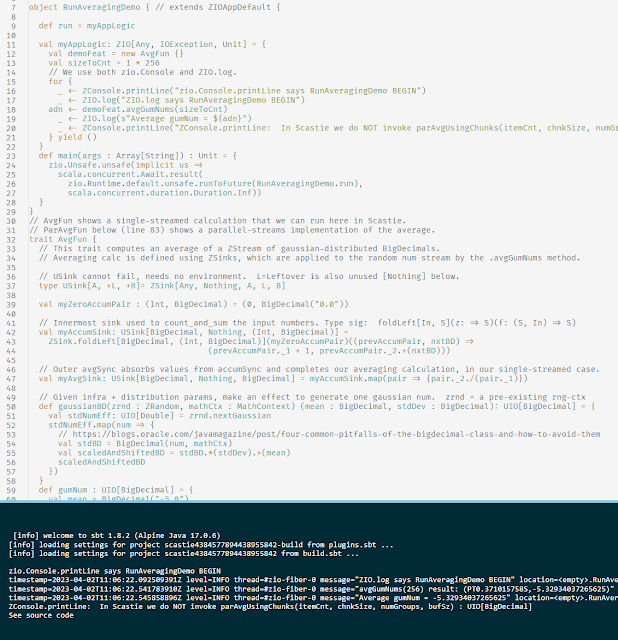Composed stochastic proof : joint distribution monad as dependent type (part 3 of 4)
composed stochastic proofs - motivation
Dependent Types for Giry probability monads, e.g. Kantorovich / Wasserstein (+ followup comment)
Asset Allocation Example.
joint distribution monad as dependent type
We define our strong typed stochastic computing structure in these 3 stages
1) Mathematically, in informal human-readable equations and type descriptions
(formally encoded and exposed as visible API in 3 below, using infra from 2)
2) As functional abstractions, using the kantorovich monad formulation
(formally encoded as submerged infrastructure, used by 3 below)
3) As a formal dependent-typed API usable from suitably strong-typed environments such as
- Lean, F*
- Idris
- Agda, Coq, Isabelle, HOL, MMT
- Scala 3 (Dotty)
Restating the WHAT: The software types defined formally in 3 are refinements of the informal types from 1, relying on an infrastructure of types and proofs for the kantorovich monad from 2.
Restating the HOW: Given a proof environment 3 containing sufficient elements from 2, then the API types 1 may be implemented faithfully, using dependent type engineering principles.
Our workhorse example is a robust platform-neutral distribution monad, for a finite-dimensional vector space of possible events.
- One outcome/sample is one vector.
- The distribution is presumed to be Lebesque integrable. (This presumption is enforced by our monad types).
- Primarily we are interested in cases with bounded support (where the coordinates of the sample vector are bounded).
Users see this distribution as a robust joint distribution over the dimensions of the event space.
A common example uses events in a convex subspace of euclidean R^N == The ordinary N
dimensional real vector space, with euclidean norm, which is a (Banach) complete metric space.
Then one sample X is one N-vector of real components {X_n} == (X_1, X_2, ... X_N), where each of the X_n is an in-bounds real number. In a simple example, the bounds are separable as N pairs of constraint inequalities:
{B_n_MIN <= X_n <= B_n_MAX}
The probability of an outcome X is governed by D_X, the distribution of X, which to a user is a
joint probability distribution over the components {X_n}.
D_X is usable both analytically and numerically:
- D_X is composable using monadic laws, to produce conditionals, marginals, expectations, moments
- D_X may be used as a source of samples, for visualization and monte carlo methods
- D_X may be projected into a reduced resolution sample space.
- For example, a continuous distribution over the X_n may be projected into a coarse discrete distribution, which is still a joint distribution.
- Imagine a histogram with M bins for each X_n : {B_n_m}
- Each of the bin-sets {B_n_*} is selected independently from the others
- Total bin-level parameters required: N * M
- Reduced sample space is just Z_M ^ N, i.e. an N vector of integers between 1 and M.
- Reduced event space has M ^ N elements.
- Each of these possible events may be assigned a discrete probability, from either a computable function or a literal dataset (e.g. using frequentist statistics).
- Each discrete probability may be reliably assigned as a rational number, enabling proof that the distribution function is properly normalized ; i.e. it sums to 1.
- This finite description of a finite distribution over R^N is computationally tractable using integer methods.
- Demonstrate for small euclidean event-space
- Demonstrate for larger spaces and different event-space norms
- However, this finite description has fewer analytic guarantees than the original continuous distribution.
- M may be increased / decreased to trade resolution for computational workload.
- Both the continuous and discrete distributions are composable monads.
This flexible applicability of D_X allows us to design and perform useful, sharable
experiments with minimal attention (initially) to platform considerations.
D_X is a verifiable stochastic model, not a platform-dependent piece of implementation code.
When a particular distribution is proven useful, then it may be promoted into use in high-scale computing environments (potentially with our proof system compiled into the runtime).
Resources for understanding the Kantorovich monad are listed and discussed in this Reddit thread:
- (Post) Dependent Types for Giry probability monads, e.g. Kantorovich / Wasserstein
- (Comment) Followup with additional details
- The Kantorovich Monad - article by Paolo Perrone at the n-Category Cafe
- Banach_space on Wikipedia
"a Banach space is a vector space with a metric that allows the computation of vector length and distance between vectors and is complete in the sense that a Cauchy sequence of vectors always converges to a well defined limit that is within the space." - Monads of probability, measures, and valuations at nCatLab
- Preview of Reddit post in r/depdendent_types
- Preview of followup Reddit comment in r/depdendent_types


